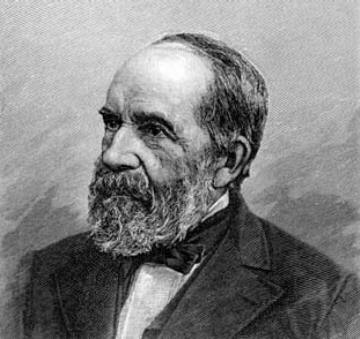Leo Lesquereux (1806-1889)
paleobotanist
|
Leo Lesquereux wrote portions of the reports of the Kentucky, Arkansas, and Indiana State Geologists whose headquarters were in New Harmony. The three reports are cited below. Lesquereux's specialty was fossil plants, especially in connection with coal deposits.
Lesquereux was born in Fleurier, Switzerland. When a boy, during an excursion to gather wildflowers, he fell from a mountaintop. "Rolling and dropping from cliff to cliff, a descent of several hundred feet," reported a lifetime later by J. Peter Lesley to the American Philosophical Society,
. . . he was found by his family hanging in the branches of a tree, mangled in every part of his body, and apparently dead; but after lying insensible for several weeks, he recovered health and strength . . .
|

|
The peat bogs near his home were young Lesquereux's favorite places, and, according to Lesley, he "devised...an auger...with an adjustable handle; and with this tool he investigated the character and structure of the bog... He was the first to determine the true causes and conditions of peat formation; unconsciously making the first step in the science of the geology of coal."
Lesquereux went to Neufchatel for his education, and there he presented his theories about peat formation. At first they were rejected, but once permitted to demonstrate his ideas on the bog itself, his theories gained acceptance.
In 1830, Lesquereux married the Baroness Sophia of Eisenach, daughter of one of Goethe's close friends. He had begun teaching science when an illness caused him to become completely deaf. He was slowly nursed back to health by his devoted wife, who supported the family herself until he was able to resume his livelihood as an engraver of watches.
When Lesquereux was nearly forty, the King of Prussia commissioned him to investigate the origin, growth, size, and economic potential of the peat bogs of Prussia. Having carried this out, Lesquereux then traversed several European countries and the Dismal Swamp of Virginia and North Carolina. Lesley reports that Lesquereux was often "alone, unarmed and deaf, far over the prairies of the West, sleeping on the grass without covering, sometimes several nights in succession." Lesley continues:
Lesquereux followed Agassiz, Desor, Guyot and Matile to America in 1848. He settled his family in Columbus, Ohio, where his sons began business on several thousand dollars' worth of watches loaned for this purpose by their father's friends, who took that method of enlarging their trade. Agassiz had promised him scientific employment, but was unable to carry into effect his friendly intentions. The family were at first in great distress; afterwards they prospered; and the father was able to devote the rest of his life to his adopted science."
According to Lesley, Lesquereux remained poor, and poorly paid for his work. He was humble in dealing with others and felt that he was imposing on those he did not know well because of his deafness. Frequently he asked for those talking to him to repeat themselves, especially if they didn't realize that he must lip-read them, or if the speaker wore a beard.
"When introduced to a stranger, and usually when meeting one of his old friends," Lesley writes, "the first question was: Will you speak in German, in French, or in English?
"Did you tell me that your friend Lesquereux was deaf?" someone once asked Lesley, who replied yes.
"But how is that possible? I noticed him talking French in the most animated manner with his friend just now, and he seemed to hear him as well as you or I could."
Today, Lesquereux is remembered not only as a paleobotanist, but also as an exemplary deaf scientist. This aspect of his life and his influence in this area are described in
Harry G. Lang, Silence of the Spheres: The Deaf Experience of the History of Science, Bergin & Garvey, Westport, Connecticut, 1994.
Lang includes an often quoted remark made by Lesquereux during an interview:
My associations have been almost entirely of a scientific nature. My deafness cut me off from everything that lay outside of science. I have lived with Nature, the rocks, the trees, the flowers. They know me, I know them...
Among 78 of Lesquereux's publications cited in
John M. Nickles, Geologic Literature on North America 1785-1918, Part I. Bibliography, U.S.G.S., Government Printing Office, Washington, 1923
are the three reports mentioned above in connection with the New Harmony geologists David Dale Owen and Richard Owen:
Leo Lesquereux, Paleontological report of the fossil flora of the Coal Measures of the western Kentucky coal field, in David Dale Owen, Kentucky Geological Survey, Report No. 3, Frankfort, 1857; pages 499-556.
Leo Lesquereux, Botanical and paleontological report on the geological state survey of Arkansas, in David Dale Owen, Second report of a geological reconnaissance of the middle and southern counties of Arkansas, Philadelphia, 1860; pages 295-399.
Leo Lesquereux, Report on the distribution of the geological strata in the Coal Measures of Indiana, in Richard Owen, Report of a geological reconnaissance of Indiana..., Indianapolis, 1862; pages 269-341.
The quotations used in the above account come from
J. Peter Lesley, "Obituary Notice of Leo Lesquereux," Proceedings of the American Philosophical Society 28 (1890) 65-70.
Probably the most thorough description of Lesquereux's life and work is
J. Peter Lesley, "Memoir of Leo Lesquereux," Biographical Memoirs of the National Academy of Sciences 3 (1895) 187-212.
Image of Leo Lesquereux used by permission of Smithsonian Institution Archives, RU 7177, George P. Merrill Collection.
Search results for "taxa Lesquereux"
Lesquerella, a plant genus named in honor of Leo Lesquereux
Search the Department of Paleobiolgy Collections (for species authored by Lesquereux
New Harmony Scientists, Educators, Writers & Artists
Clark Kimberling Home Page
